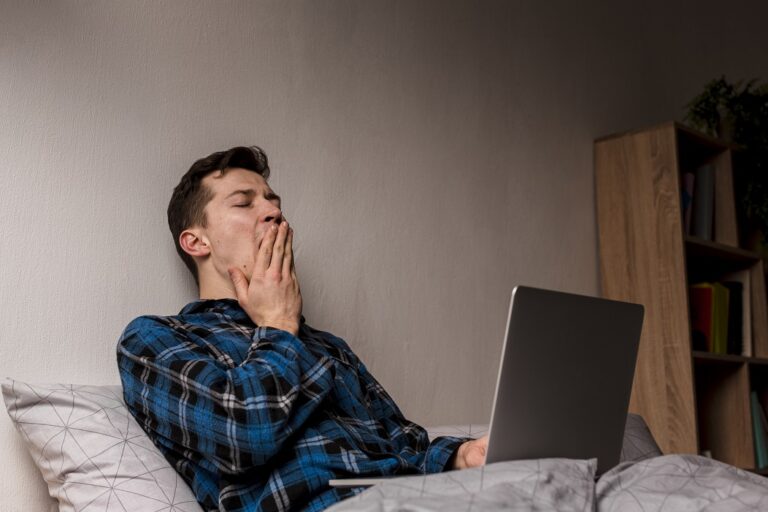
How Does It Inspire Sleep Work?
Inspire Sleep is a medical device used to treat obstructive sleep apnea (OSA) in adults. It works by delivering mild stimulation to the hypoglossal nerve, which controls the movement of the tongue and other muscles involved in breathing.
During sleep, when the muscles in the throat and tongue relax, they can collapse and block the airway, causing OSA. The Inspire Sleep device senses when breathing has stopped or become shallow and then stimulates the hypoglossal nerve to move the tongue and other muscles to open up the airway.
The device is implanted in the chest with a small wire leading to the hypoglossal nerve. A remote control is used to turn the device on and off, adjust the stimulation settings, and check the battery level.
Inspire Sleep is typically recommended for people with moderate to severe OSA who cannot tolerate or do not benefit from continuous positive airway pressure (CPAP) therapy, which is another treatment for OSA that involves wearing a mask over the nose and/or mouth during sleep to deliver a steady stream of air pressure to keep the airway open.
Some Benefits of Inspire Therapy for Sleep Apnea
The device senses the patient’s breathing patterns during sleep and delivers mild stimulation to the hypoglossal nerve, which controls the tongue and other key muscles involved in breathing. This stimulation helps keep the airway open and reduce or eliminate apneas and hypopneas.
Here are some benefits of Inspire Therapy for sleep apnea:
Improved Sleep Quality: Inspire Therapy can significantly improve the quality of sleep for people with obstructive sleep apnea. By reducing the number of apneas and hypopneas that occur during the night, patients are able to get more restful sleep.
Increased Energy and Alertness: With improved sleep quality, patients typically report feeling more energetic and alert during the day. This can lead to improved cognitive function, better productivity at work, and an overall better quality of life.
Reduced Health Risks: Sleep apnea is associated with a range of health risks, including high blood pressure, heart disease, stroke, and diabetes. By effectively treating sleep apnea, Inspire Therapy can help reduce these risks and improve overall health.
Alternative to CPAP: Continuous positive airway pressure (CPAP) is a common treatment for sleep apnea, but many patients find it uncomfortable or difficult to use. Inspire Therapy provides an alternative treatment option for patients who are unable to tolerate CPAP.
Does Inspire Sleep Work for Sleep Apnea?
Yes, Inspire Sleep is an effective treatment option for sleep apnea. It is a small device that is surgically implanted under the skin in the chest area, and it works by stimulating the hypoglossal nerve, which controls the movement of the tongue and other muscles in the airway. By stimulating these muscles, the airway is kept open during sleep, reducing or eliminating apnea events. Inspire Sleep has been shown to significantly reduce sleep apnea events in clinical studies, and it is a good option for patients who cannot tolerate or are not good candidates for continuous positive airway pressure (CPAP) therapy. However, as with any medical procedure, it is important to discuss the potential benefits and risks with your doctor.
Who Cannot Use Inspire for Sleep Apnea?
Inspire is a type of sleep apnea treatment involving surgically implanting a device that delivers mild electrical stimulation to the airway muscles during sleep, thereby keeping the airway open and reducing apnea events.
However, not everyone with sleep apnea is a candidate for Inspire. Some factors that may exclude someone from using Inspire for sleep apnea include:
Anatomical issues: The anatomy of the upper airway may make it difficult or impossible to implant the Inspire device. For example, if a person has a severely collapsed or narrow airway, the device may not be able to deliver effective stimulation.
Other medical conditions: Certain medical conditions, such as chronic lung disease or neuromuscular disorders, may make it unsafe or ineffective to use Inspire.
Body weight: Obesity is a common risk factor for sleep apnea, but in some cases, it may also make it difficult to use Inspire. The device requires a certain amount of subcutaneous tissue to function properly, and in very lean individuals, this may not be possible.
It’s important to note that only a qualified medical professional can determine whether Inspire is a suitable treatment option for a particular individual. If you’re considering Inspire for sleep apnea, be sure to talk to your doctor about your options and any potential risks or limitations.
What Is the Best Surgery for Sleep Apnea?
The best surgery for sleep apnea depends on the severity and cause of the condition. Sleep apnea is a serious condition that causes interruptions in breathing during sleep.
The most common surgical options for sleep apnea include:
Uvulopalatopharyngoplasty (UPPP): This surgery involves removing excess tissue from the back of the throat, including the uvula, tonsils, and part of the soft palate. UPPP can be effective in treating mild to moderate sleep apnea caused by excess tissue.
Maxillomandibular advancement (MMA): This surgery involves moving the upper and lower jaws forward to increase the size of the airway. MMA is often recommended for people with moderate to severe sleep apnea and a small jaw.
Genioglossus advancement (GA): This surgery involves moving the tongue muscle forward to prevent it from obstructing the airway during sleep. GA is often recommended for people with mild to moderate sleep apnea and a small lower jaw.
Conclusion
It is important to note that surgery is not always the best option for treating sleep apnea, and it should only be considered after consulting with a sleep specialist and undergoing a comprehensive evaluation. Other non-surgical treatments, such as weight loss, avoiding alcohol and sedatives, and positional therapy, may also be effective in treating sleep apnea.